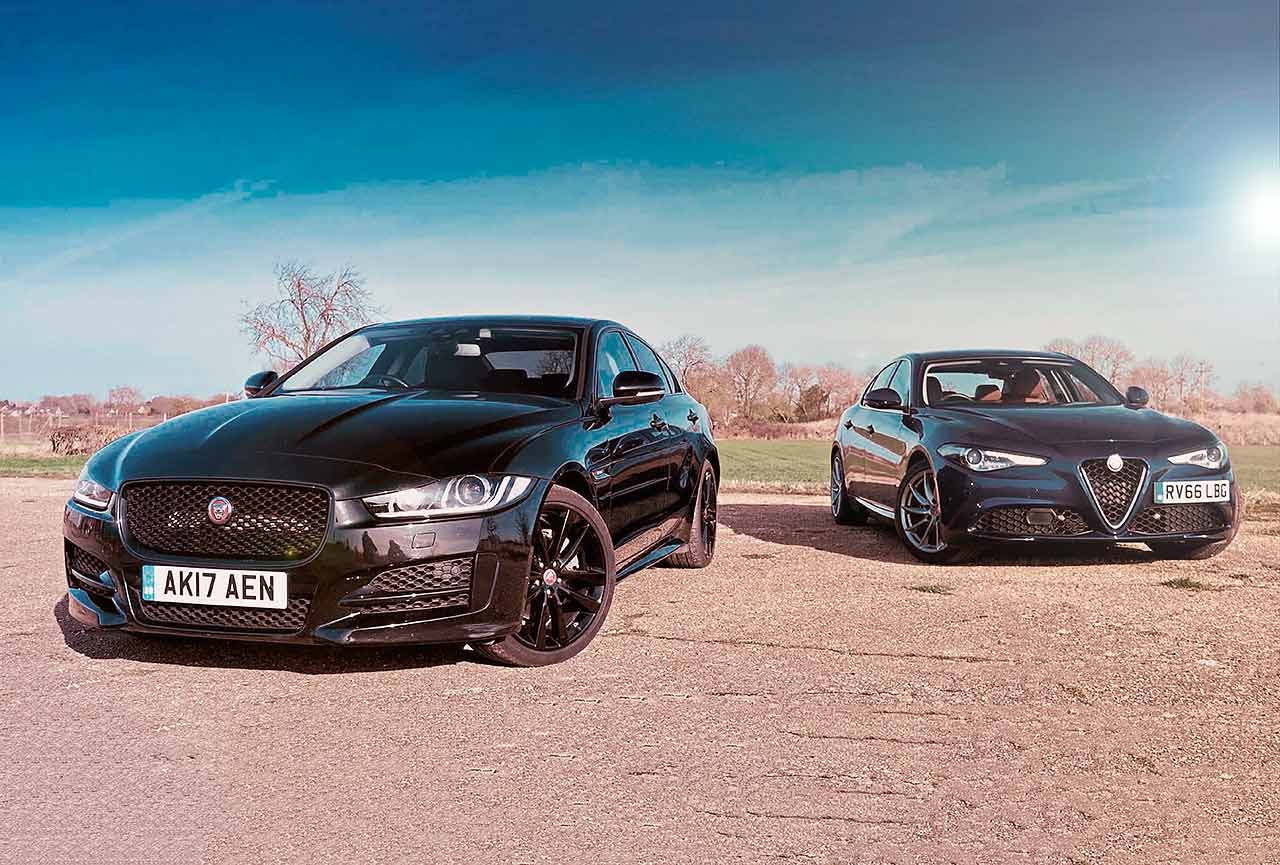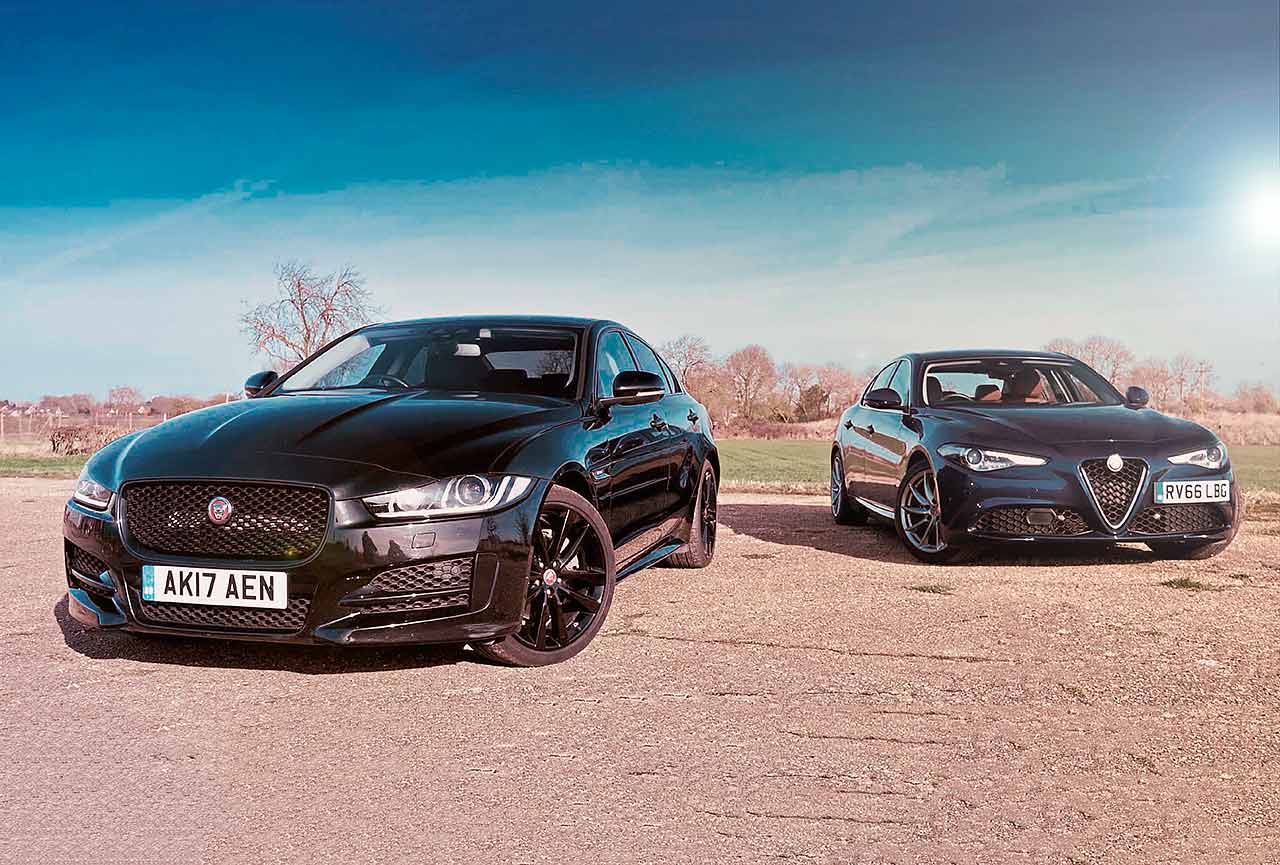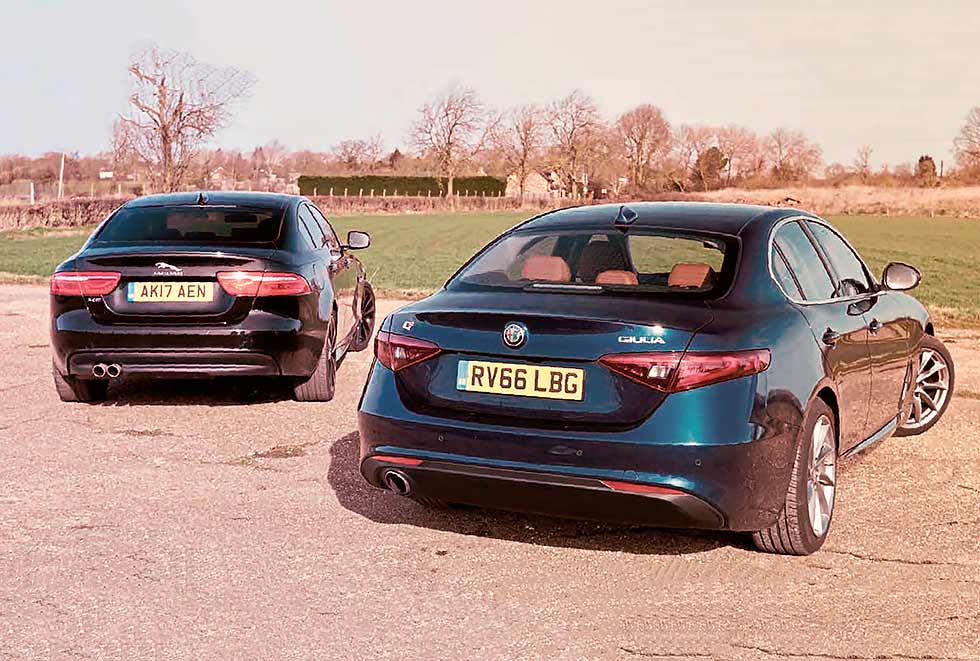
Twin test Dare to be different Jaguar XE vs. Alfa Romeo Giulia… Which is the best compact executive saloon that isn’t German – the Jaguar XE or the Alfa Romeo Giulia? German marques might rule the compact saloon market, but there are more interesting left-field alternatives, such as the Jaguar XE and Alfa Romeo Giulia. We drive both to find out which is the best. Words Richard Aucock. Photography Paul Walton.
If you’ve reached middle management, usually the hardest decision you’ll need to make with your company car allowance is which German brand to go for this time around – Audi, BMW, or Mercedes-Benz.

The dominance of these is near absolute, others barely get a look-in. Count yourself lucky if you see a Lexus IS or an Infiniti Q50 during a rare moment of rest in the motorway services. Yet two of the strongest arguments for eschewing Germany also come from Europe. The British Jaguar XE has been around a few years, and has made a bit of an impact, but perhaps not as great as Jaguar would have liked. The Italian Alfa Romeo Giulia has caused much more of a stir, in no small part because it is a genuinely class-competitive Alfa at long, long last. One motoring title in the US even made it Car of the Year.
With not a German car in sight, we decided to embrace the left field and bring them both together. And it was with slight awkwardness that we Jaguar enthusiasts initially started cooing over the Alfa. It’s such a pretty car at first glance, with gentle, sensuous curves and just the right amount of detailing to leave it oozing class. When I drove it to the photoshoot I was well aware of just how many heads it was turning and admiring glances it was earning.
The XE is more of a slow burner, and the black of the test car does it no favours. Because although it doesn’t jump out at you, it’s an extremely well-proportioned car with the same gentleness of surfacing demonstrated by the Alfa. Here, it’s the sculptural stance of the surfaces that do the work, rather than the more heart-on-sleeve beauty of the Alfa. It’s particularly pleasing around the rear three-quarter angle.

You sense the Alfa will age before the Jaguar, which is a shape that – if you stop to appreciate it – has a lot to commend it. Three years on, it has barely dated. Perhaps, whisper it, Jaguar just needs a bit of the glitz you get on the Alfa to make it stand out. Ian Callum won’t like it, but the marketing division may yet force his hand.
Enough standing around. We have keys in hand and cars to photograph. By now, we’ve drifted back to fawning over the Alfa. This time, the ‘oohs’ and ‘aahs’ are for its interior. No argument – the Alfa has a wonderfully alluring cabin. The Jaguar does not.
It helps that the luscious blue of our test Giulia is so gorgeously offset by rich tan leather trim. You know, the sort of combination you once found on Ferrari GT cars, which today makes people weak-kneed when they encounter them at classic auctions. Tug the satin-finish metal doorhandle and the leathery aroma hits you first, then the charm of the interior draws you in.
The dash has a tan-and-black colour split that works well, and prominent round air vents at either side, plus dual deeply-cowled dials ahead of the driver. The embossed Alfa badge on the flatbottom steering wheel is like a trophy and the wheel itself a gem to hold – the thickness, the softness of the leather, the sculpting around the spokes. Add in massive real metal auto gearshifters (all UK Giulias are eight-speed auto) and the treat of a steering wheel-mounted starter button and you have something that makes the Jaguar seem a dullard.
The Alfa’s not perfect: the gearshift lever is cheap and the infotainment system a real let-down. But you forgive it this, not least because the quality of the main materials is appealing enough to help you overlook details such as flimsy column stalks and nasty steering wheel buttons.
The XE is a pale imitation by comparison. Even at launch, its interior was marked out as a weakness, and you sense that even Jaguar knows this. If the plain, dull shape doesn’t put you off, the vinyl-like materials and scratchy lower plastics will. Again, our test car is unremitting black, which again doesn’t help, but the fact that Alfa’s tried in areas Jaguar hasn’t really doesn’t help the Brit’s case.
When started up, the (optional) electronic dial cluster looks lovely. With the engine off, it’s just a black box. Same for the touchscreen infotainment, below which sit dull rows of buttons and more black panel displays. Peer through the window in a car park and it’s like looking at something from the early 2000s. Only the low-set air vents, positioned far outside the dash and eating into the concave door panels, add the tiniest bit of spice.
Fortunately, if you don’t stare too hard at the surroundings, the Jaguar is a much nicer place to be. The seats go down low for starters, so you really feel like you’re sitting in it, rather than on it. The seats themselves are firmer and more supportive than the Alfa’s, and the driving position is more purposeful, with inch-perfect placement of the major controls. The centre console is high, the good-to-hold steering wheel comes nice and close and the manual gearlever is positioned perfectly. Again, Jaguar, the basics are right, but you missed the last ten percent once again. Oh, and the door pockets are disgracefully small.
Time to hit the road. I’ve already spent a lot of time in the Alfa, so swap to the Jaguar. Before I do, I tell editor Walton how impressed I am with the Alfa’s depth, the tidiness of its rear-drive chassis, the taut control of its ride. The car we’re in is a petrol, for photographs, but I’d earlier driven the diesel alternative for 1,000 miles, so can vouch for the engine’s relative refinement, save for a bit too much audible tickover clatter.
I’ve spent a lot of time in the XE, but not for a few months. My challenge now is to familiarise myself with it and see how it measures up to the Alfa. And the aforementioned idle rattle I mentioned with the diesel Giulia? It’s worse still with the Jaguar. Crank the 2.0-litre Ingenium diesel and the whole aluminium-intensive structure shudders before settling to a vibro-massage of diesel rumble as it idles. This was something I noted from my very first drive in the XE, and it has not got any better with time. It’s the engine’s single biggest failing, and a significant one.
And it’s a shame, too. Because, ironically, get it revving, and the Ingenium is uncommonly smooth and free-revving for a diesel. Editor Walton has done the warming up for me, so I can get straight onto it, and the motor is soon singing as much as any four-pot diesel can. It’s perfectly happy zinging along in the mid-range (around 3,000rpm), where it serves up keen throttle response and enough of a power band in reserve to make easy progress. On country roads, third and fourth gear are all you need, and you won’t feel pained to leave it revving rather than changing up before reaching the next corner. Perhaps you might, though, because the manual gearchange is also a treat. Early XEs seemed a bit notchy and forgettable, but our well-used test car has loosened up nicely, delivering a super-snicky shift that is quick, precise and efficient. With the clutch giving good feedback too (an oft-overlooked facet of driver satisfaction), I enjoy blatting through the gears in the XE as much as I do in a dinky rear-drive roadster such as a Mazda MX-5.
And then, there’s the chassis. The XE’s single biggest highlight. This is a genuinely terrific driver’s car, one more engaging than any Audi or Mercedes-Benz rival, even better than the latest BMW 3 Series, and certainly classier than the comparable Alfa here. It’s exceedingly able and well sorted. On flowing roads, it flows with you, combining impeccable body control with a fantastic ride – one that absorbs lumps, bumps and undulations with absolute precision, but without jar, wallow or thump. The steering is progressive, clear and linear with faultless weighting, and response to input is exceptionally well measured.
The XE lets you flow through snaking sequences at high speed with total confidence. Charge down to tight bends, hard on the confidence-inspiring brakes, arrow it into a tight bend and then get on the power super-early, rear end settling nicely, front inside wheel grabbing the apex with clarity and sticky, slide-free assurance. I was having so much fun in this cooking-looking saloon car, I had to stop and write it all down. Like the finest Jaguars of old, it’s an exceptionally accomplished driver’s car compared to its rivals.
Get back into the Alfa and the strengths of the Jaguar shine brighter still. The Giulia’s seating position for starters is too high, and the seats not as supportive, so you feel a bit less confident even before the off. Then, there’s the apparent lack of chassis rigidity compared to the Jaguar: the XE is the stiffer, more solid machine, with less creak and crack over tough road scars, and a sense of greater accuracy courtesy of tighter tolerances.
Jaguar’s more measured steering comes more naturally than the Alfa’s hyper-fast set-up. On the way across, I’d become used to the Alfa’s and was steering with wrist-snick accuracy. Time back with a ‘normal’ set-up soon loses you this calibration, though, making the Giulia feel nervy and darty – and it has neither the feel nor the natural weighting of the Jaguar, either.
The chassis is still enjoyable, though, aided here by adaptive dampers and a rear limited-slip differential (hence the ’Q2 badge on the rear). Perhaps inevitably, it’s a bit more upfront than the Jaguar, and doesn’t have the XE’s classy scope across challenging British roads. But, the tauter, more eager drive is still enjoyable, becoming more so once you’ve had half-an-hour or so behind the wheel to get used to it. Again, it’s more engaging than a C-Class or A4, and its charisma might steer some to take it over a 3 Series, even if the BMW ultimately has more substance.
I love the engine, too. With the anti-diesel mood right now, comparing a turbo petrol with the Jaguar’s turbo diesel is quite interesting: certainly the XE delivers better mileage, but I still surprise myself by getting high-30s in the Alfa, and its more charismatic, fruitier nature is nicer than the flawed XE, particularly in stop-start motoring. By now, I’d been driving almost non-stop for eight hours. It was time to take a breather and check out the details. Yup, both are tight in the back, the Jaguar more so than the Alfa. Their saloon boots are so-so, and some will regret the fact that neither car is available as an estate (all the Germans have a wagon alternative). And, no matter which angle you look at, with this pairing at least, your eyes can’t help but be drawn to the attractive and charming Alfa instead of the pretty but plain-Jane Jaguar.
How do they measure up on costs? For parity’s sake, let’s compare like with like. You can get a 2.0D 180 R-Sport XE, like the one pictured, for £33,500. Add on an auto and it’s £35,285. The Alfa comes in 2.2 JTDM-2 180 diesel guise for £33,315, which means it costs less than the Jaguar even before you add on the auto (although the test car did have a huge haul of options). You can get a 200bhp petrol like the one we drove here for £31,575, while an Ingenium 200 R-Sport XE (with a standard auto) is £31,045. So, swings and roundabouts – and, as the stats tables show, it’s a similar story with performance, CO2 and economy.
The Giulia is the charmer of the two, and your heart will be won over by it. Get beyond the allure, though, and you’ll discover the XE is the car with greater depth. The Alfa is still capable, but it’s the Jaguar that delivers more, no matter what the road. The challenge at Whitley now is to try and give the XE the visual boost outside and in, to complement these talents, and let the world know once and for all what a good car it actually is. Roll on mid-life facelift time.
TECHNICAL DATA FILE SPECIFICATIONS 2018 Jaguar XE 2.0d 180 R-Sport
Engine 1,999cc 4cyl
Max Power 180PS / DIN
Max Torque 280lb ft / DIN
0-60mph 7.9secs
Max speed 140mph
Transmission six-speed manual
Weight 1,490kg
Economy 67.3mpg
CO2 138g/km
Price £33,515
TECHNICAL DATA FILE SPECIFICATIONS 2018 Alfa-Romeo Giulia 2.0T 200 Super
Engine 2.0T 200
Max Power 200bhp / DIN
Max Torque 244lb ft / DIN
0-60mph 6.6secs
Max speed 146mph
Transmission eight-speed auto
Weight 1,429kg
Economy 75mpg
CO2 99g/km
Price £31,575
“I am impressed with the Alfa’s depth, the tidiness of its rear-drive chassis, the taut control of its ride”
“The seats themselves are firmer and more supportive than the Alfa’s, and the driving position is more purposeful, with inch-perfect placement of the major controls”





